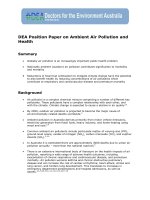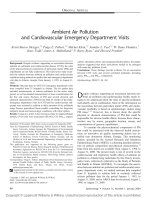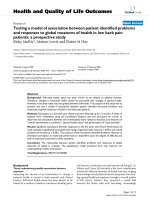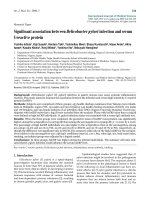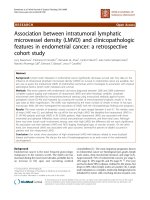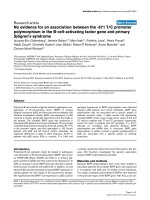Association between ambient air pollutants and preterm birth in Ningbo, China: A time-series study
Bạn đang xem bản rút gọn của tài liệu. Xem và tải ngay bản đầy đủ của tài liệu tại đây (717.29 KB, 9 trang )
Liu et al. BMC Pediatrics (2018) 18:305
/>
RESEARCH ARTICLE
Open Access
Association between ambient air pollutants
and preterm birth in Ningbo, China: a
time-series study
Wen-Yuan Liu1†, Zhe-Bin Yu2,3†, Hai-Yan Qiu1†, Jian-Bing Wang2,3†, Xue-Yu Chen2 and Kun Chen2,3*
Abstract
Background: Exposure to air pollutants has been related to preterm birth, but little evidence can be available for
PM2.5, O3 and CO in China. This study aimed to investigate the short-term effect of exposure to air pollutants on risk
preterm birth during 2014–2016 in Ningbo, China.
Methods: We conducted a time-series study to evaluate the associations between daily preterm birth and major air
pollutants (including PM2.5, PM10, SO2, NO2, O3 and CO) in Ningbo during 2014–2016. A General Additive Model
extend Poisson regression was used to evaluate the relationship between preterm birth and air pollution with
adjustment for time-trend, meteorological factors and day of the week (DOW). We also conducted a subgroup
analysis by season and age.
Results: In this study, a total of 37,389 birth occurred between 2014 and 2016 from the Electronic Medical Records
System of Ningbo Women and Children’s Hospital, of which 5428 were verified as preterm birth. The single
pollutant model suggested that lag effect of PM2.5, PM10, NO2 reached a peak at day 3 before delivery and day 6
for SO2, and no relationships were observed for O3 and preterm birth. Excess risks (95% confidence intervals) for an
increase of IQR of air pollutant concentrations were 4.84 (95% CI: 1.77, 8.00) for PM2.5, 3.56 (95% CI: 0.07, 7.17) for
PM10, 3.65 (95% CI: 0.86, 6.51) for SO2, 6.49 (95% CI: 1.86, 11.34) for NO2, − 0.90 (95% CI: -4.76, 3.11) for O3, and 3.36
(95% CI: 0.50, 6.30) for CO. Sensitivity analyses by exclusion of maternal age < 18 or > 35 years did not materially
alter our results.
Conclusions: This study indicates that short-term exposure to air pollutants (including PM2.5, PM10, SO2, NO2) are
positively associated with risk of preterm birth in Ningbo, China.
Keywords: Preterm birth, Air pollution, Time-series analysis, PM2.5, PM10, SO2
Background
Preterm birth, defined as less than 37 weeks of gestations, is the second largest direct cause of child deaths
among children less than 5 years [1]. There are 15
million premature birth annually worldwide and China
contributed 1.1 million (rank 2nd worldwide) according
to international survey data [2]. Preterm birth account
* Correspondence:
†
Wen-Yuan Liu, Zhe-Bin Yu, Hai-Yan Qiu and Jian-Bing Wang contributed
equally to this work.
2
Department of Epidemiology and Biostatistics, School of Public Health,
Zhejiang University, Hangzhou 310058, China
3
Research Center for Air Pollution and Health, Zhejiang University, Hangzhou
310058, China
Full list of author information is available at the end of the article
for 75% of perinatal mortality and more than half the
long-term morbidity [3]. Moreover, the survived preterm
babies are at increased risk of neuro-developmental impairments, respiratory and gastrointestinal complications
[3]. The etiology of preterm birth remains unclear yet
many risk factors have been explored.
There is increasing evidence that exposure to ambient
air pollutants is associated with preterm birth [4–9]. A
systematic review has reported positive associations between air pollutants and risk of adverse birth outcomes
including preterm birth [5]. And a recent meta-analysis
of 23 studies has also showed that a significantly
increased risk of preterm birth with interquartile range
increase in particulate matter exposure during pregnancy
© The Author(s). 2018 Open Access This article is distributed under the terms of the Creative Commons Attribution 4.0
International License ( which permits unrestricted use, distribution, and
reproduction in any medium, provided you give appropriate credit to the original author(s) and the source, provide a link to
the Creative Commons license, and indicate if changes were made. The Creative Commons Public Domain Dedication waiver
( applies to the data made available in this article, unless otherwise stated.
Liu et al. BMC Pediatrics (2018) 18:305
[10]. It should be noted that findings of exposure to air
pollution and preterm birth from Western countries may
not be applicable to the Chinese populations due to higher
air pollution levels, genetic and physiological differences.
However, a recent systematic review, included all studies
in China, showed the effect of air pollution on preterm
birth was inconsistent [11].
In this study, we used birth data during 2014–2016 in
Ningbo, Zhejiang Province, China, and conducted a
time-series study to investigate the association between
exposure to ambient air pollutants and risk of preterm
birth.
Page 2 of 9
the Environmental Monitoring Center of Ningbo City
( The daily
concentrations of each pollutant were averaged from the
available monitored results of eight stations which were
monitored by the China National Quality Control. The
eight stations were “Shi Jian Ce Zhong Xin”, “Tai Gu Xiao
Xue”, “San Jiang Zhong Xue”, “Wan Li Xue Yuan”, “Huan
Bao Da Lou”, “Long Sai Yi Yuan”, “Qian HuShui Chang”
and “Wan Li Guo Ji”. The distribution of these 8 monitor
stations in Ningbo was shown in Additional file 1: Figure
S1. Air pollutants were measured in the unit of micrograms per cubic meter(μg/m3) except milligrams per cubic
meter (mg/m3) for CO.
Methods
Study population
Statistical analysis
This study was conducted in Ningbo, which located in
the southeast of China and composed of six districts and
has a metropolitan area population of 7.8 million. We
obtained anonymous births information from the
Electronic Medical Records System (EMRS) in Ningbo
Women and Children’s Hospital (the largest women’s
hospital in Ningbo) from 2014 January 1st to 2016
December 31st. A total of 40,968 birth records were included in the EMRS. Duplicated records (n = 2305),
non-live birth records (n = 230), twin pregnancy and
multiple pregnancies (n = 1274) and birth records with
extreme gestational age (< 20 weeks) (n = 160) were excluded from this study. Finally, a total of 37,389 eligible
births were included in our study.
Distribution of daily number of preterm births follows
the Poisson distribution due to its small probabilities.
Thus, we used a Generalized Additive Model (GAM)
extended Poisson regression [12] to explore the potential
effect of air pollution on premature birth. This method
has been widely used in air pollution time-series studies
[13–22] because of its non-parametric flexibility.
We firstly built a basic model based on the daily number of preterm births without air pollution variables. To
control for non-linear trend between preterm birth and
time or weather conditions, we added time-dependent
variables including calendar time, temperature and
relative humidity via natural spline functions. Degree of
freedom (df ) for natural spline functions were adopted
by generalized cross-validation (GCV) scores [12]. Day
of the week was also included as a dummy variable in
the basic models. Then, each air pollutant was added
into a single-pollutant model separately. The number of
gestations at risk of preterm birth was used as an offset.
In brief, we fitted the following model to evaluate the
effect of air pollutants on preterm birth:
Preterm birth
Preterm birth was defined as a singleton live-birth delivery before 37 completed weeks of gestation(< 259 days)
[1]. Gestational age was calculated based on the date of
women’s last menstrual period (LMP). For women who
had no LMP date, gestational age was substituted by a
clinical estimate. A total of 5428 preterm births were
finally included for the current analysis. The number of
preterm births was calculated for each day from 2014
January 1st to 2016 December 31st. The study was
reviewed and approved by Committee of ethics, Ningbo
Women and Children’s Hospital.
Air pollution and meteorological exposure
Daily meteorological data including mean temperature
(degree Celsius) and relative humidity(percent) were
collected from the Ningbo Meteorological Bureau. Daily
values for temperature and relative humidity were calculated by averaging 24 hourly monitoring data.
Daily mean concentrations of air pollutants, including
particulate matter (aerodynamic diameter less than or
equal to 2.5 μm (PM2.5) and 10 μm (PM10)), sulfur dioxide
(SO2), nitrogen dioxide (NO2), Ozone (O3) and carbon
monoxide (CO) during 2014 to 2016, were collected from
Log½EðYt Þ ¼ α þ βZt þ S ðtime; df Þ
þ S ðtemperature; df Þ
þ S ðrelative humidity; df Þ
þ DOWt ðday of the weekÞ þ Offsett
In this formula, t represents the day of the observation;
Yt represents daily number of preterm births, E(Yt) stands
for the expected values for the number of premature
births on day t. α is residual, β is the regression
coefficient, and Zt is the average concentration of air pollutants on the observed day or over several days. S (time,
df) is the calendar time smoothing spline function, S
(temperature, df) is the daily temperature smoothing
spline function, S (relative humidity, df) is the daily relative humidity smoothing spline function, and DOWt is a
dummy variable with Monday as a reference. The corresponding degree of freedom for time, temperature and
Liu et al. BMC Pediatrics (2018) 18:305
Page 3 of 9
relative humidity in the spline function were 7, 7 and4 in
the final model.
We investigated the acute effect on the risk of preterm
birth by adding the concentration of each pollutant into
the model for a 1-day exposure window with lag-time
from 1 to 6 days before birth. Cumulative effect was also
calculated by including the lag moving average
(Avg1-Avg6) into the model. Relative risks (RRs) and
95% confident intervals (CIs) were calculated by the regression coefficient β of air pollutants. And we reported
excess risks (ERs) and 95% CIs that represented a
percent increase in daily preterm birth risk per IQR increase in air pollutant concentrations. ER was calculated
as follows: ER = (RR ‐ 1) × 100%. We also examine the
exposure-response curve by using a natural spline function for certain pollutants in the GAM model. Goodness
of fit of the model was assessed by using Akaike
Information Criterion (AIC). The best df for each air
pollutant was indicated by the lowest AIC value in the
GAM model.
Sensitivity analysis by exclusion of maternal age < 18
or > 35 years in preterm birth records was conducted to
evaluate the robustness of our results, because women
aged < 18 or > 35 years had a higher possibility to
develop a preterm birth [23]. And we further divided
the study period into cold period (November to April)
and warm period (May to October). Models were
fitted separately in two periods to check if any difference in the effect of air pollutants on preterm birth
during warm and cold periods. 95% confidence interval for the difference in effect estimates between two
strata (a potential effect modifier) was calculated as
follows:
Where Q1 and Q2 are the adjusted estimates from
two strata (e.g. cold and warm period), and SE1, SE2 are
the corresponding standard errors [24].
Continuous variables with normal distribution were
presented as mean ± standard deviation (SD), and
non-normal variables were reported as median ± interquartile range (IQR). Spearman’s correlation coefficient
was used for the correlations between ambient air pollutants and meteorological factors. P < 0.05 was considered statistically significant. All statistical analyses were
conducted by using R 3.3.1.
Results
Descriptive results of exposure and outcomes
The descriptive results of air pollution and meteorological data are shown in Table 1. The mean daily
concentrations of PM2.5, PM10, SO2, NO2, O3 and CO
during 2014 to 2016 were 43.73 μg/m3, 69.69 μg/m3,
16.56 μg/m3, 40.50 μg/m3, 64.33 μg/m3, 1.06 mg/m3, respectively. Concentrations of air pollutants were higher
in the cold period than those in the warm period except
for O3. Daily mean ambient temperature and relative humidity were 17.4 °C and 76.8%.
A total of 5428 preterm births were identified among
the total valid births of 37,159. Overall prevalence of
preterm birth was 14.61%. The number of births in
women with the maternal age < 18 or > 35 years was
3452, among which 714 births were diagnosed as preterm birth (20.68%). And the corresponding prevalence
of preterm birth during cold and warm periods was
14.63% and 14.58%, respectively.
Correlation between ambient air pollutants and
meteorological factors
Table 2 shows the Spearman’s correlation analysis of air
pollution and meteorological measures. PM2.5 was
pffiffiffiffiffiffiffiffiffiffiffiffiffiffiffiffiffiffiffiffiffiÁ
À
Q1‐Q2 Æ 1:96 SE1 þ SE2
Table 1 Air pollution and meteorological data in Ningbo, China (2014–2016)
Mean ± SD
Minimum
P25
P50
P75
IQR
Maximum
14.25 ± 6.97
5.90
10.53
13.70
19.09
8.56
74.08
31.28 ± 11.94
5.59
28.00
37.38
51.34
23.34
115.00
ALL year
Cold Perioda
Warm Period
SO2 (μg/m3)
16.56 ± 9.05
18.91 ± 10.25
NO2 (μg/m3)
40.50 ± 16.88
49.85 ± 15.99
Air pollutants
3
PM10 (μg/m )
69.69 ± 38.37
87.03 ± 41.75
52.60 ± 24.85
10.18
42.90
60.20
85.31
42.41
287.10
PM2.5 (μg/m3)
43.73 ± 26.26
55.64 ± 29.38
31.99 ± 15.55
4.24
25.50
37.38
54.11
28.62
196.93
O3 (μg/m3)
64.33 ± 29.71
53.46 ± 25.07
75.05 ± 30.05
8.17
42.99
61.96
83.02
40.03
244.30
CO (mg/m3)
1.06 ± 0.35
1.13 ± 0.39
0.99 ± 0.28
0.04
0.88
1.00
1.19
0.31
2.92
Temperature (°C)
17.42 ± 8.10
10.64 ± 5.17
24.10 ± 3.76
−4.47
10.23
18.69
23.94
13.71
32.25
Relative Humidity (%)
76.8 ± 11.80
74.29 ± 13.38
79.19 ± 9.33
32.96
69.82
77.81
85.47
15.65
97.60
Meteorology
PM2.5: particulate matter less than 2.5 μm in aerodynamic diameter, PM10: particulate matter less than 10 μm in aerodynamic diameter, SO2: sulfur dioxide,
NO2: nitrogen dioxide, O3: Ozone, CO: carbon monoxide
a
Cold period was from November to April, and warm period was from May to October
Liu et al. BMC Pediatrics (2018) 18:305
Page 4 of 9
Table 2 Correlation between air pollutants and meteorological factors in Ningbo, China
SO2
NO2
PM10
PM2.5
CO
O3
Temperature
SO2
1.00
NO2
0.59
1.00
PM10
0.69
0.74
1.00
PM2.5
0.66
0.74
0.95
CO
0.22
0.45
0.43
0.47
O3
−0.13
−0.46
−0.13
−0.17
− 0.29
Temperature
−0.39
− 0.62
− 0.52
−0.50
− 0.20
0.37
1.00
Relative humidity
−0.39
−0.04
− 0.36
−0.24
0.08
−0.33
0.21
Relative humidity
1.00
1.00
1.00
1.00
PM2.5: particulate matter less than 2.5 μm in aerodynamic diameter, PM10: particulate matter less than 10 μm in aerodynamic diameter, SO2: sulfur dioxide,
NO2: nitrogen dioxide, O3: Ozone, CO: carbon monoxide
All correlations were statistically significant (P < 0.01)
Fig. 1 Excess Risks (ERs) and 95% confidence intervals (95% CIs) of daily preterm birth risk per IQR increment in pollutant concentrations at
different lag days
Liu et al. BMC Pediatrics (2018) 18:305
positively associated with SO2, NO2, PM10 and CO, but
negatively associated with O3. The strong correlation
was observed for PM2.5 and NO2 (Spearman’s Rho = 0.74,
P < 0.01). And two weather variables were negatively
related to SO2, NO2, PM2.5, PM10 and CO, but positively
related to Ozone.
Short-term effects for preterm birth
Fig 1 shows the association between air pollutants and
daily preterm births at lag0–6 days. The largest ERs were
observed at Lag3 for PM2.5, PM10 and NO2, Lag6 for
SO2 and Lag 4 for CO. No significant associations were
observed for Ozone and preterm births. The associations
between cumulative concentrations and preterm births
at different lag days (Avg1-Avg6) are shown in the
Additional file 2: Table S1. Figure 2 shows the
dose-response curve between certain air pollutants and
risk of preterm births by using a natural spline function
for air pollutants in GAM models. Nonlinear association
was observed for PM10, SO2 and preterm births.
Page 5 of 9
Table 3 and Additional file 3: Table S2 show the
excess risks and 95% CIs for short-term exposure to
air pollutants and daily preterm birth stratified by
maternal age and season. The associations between
PM2.5, PM10, SO2, NO2 and preterm birth tended to
be attenuated after we restricted the analysis in women
with the maternal age of 18–35 years, but the associations
still remained significant. In season-specific analyses, the
adverse effect of PM2.5, SO2 and NO2 on preterm birth
were stronger in cold period and attenuated in warm
period as compared with the whole year. Similar results
were observed for the effect of four air pollutants
(PM2.5, PM10, SO2 and NO2) in cold and warm
periods when maternal age was restricted from 18 to
35 years. No significant associations were observed
for Ozone. No significant interaction effect was observed for season and maternal age on the association
of short-term exposure to air pollution and preterm
birth (Additional file 4: Table S3).
Table 4 provides ERs and 95% CIs from two-pollutant
models. The effect of air pollutants on daily preterm
Fig. 2 Coefficients and 95% confidence intervals (95% CIs) of daily preterm birth risk at different pollutant concentrations using natural
spline functions
c
6.49 (1.86,11.34)
b
5.16 (1.33,9.13)
c
3.36 (0.50,6.30)
c
−6.35 (− 12.78,0.55)
9.25(3.45,15.38)
− 0.90 (− 4.76,3.11)
1.89 (−2.71,6.71)
3.23 (− 1.81,8.53)
Annual
c
0.37 (−2.84,3.70)
− 2.76 (− 7.1,1.79)
6.66(1.42,12.17)
6.56 (3.39,9.82)
c
4.88 (0.88,9.03)c
4.53 (1.09,8.09)c
c
2.29 (− 1.16,5.87)
− 3.86 (− 10.69,3.49)
10.32(3.69,17.37)
7.04 (3.29,10.92)
c
6.74 (2.12,11.58)c
4.65 (0.71,8.74)c
Cold period
0.40 (− 4.60,5.66)
1.55 (− 3.91,7.32)
2.7(−6.26,12.51)
5.53 (−0.32,11.71)
2.64 (− 5.42,11.39)
3.17 (− 4.23,11.15)
Warm period
c
7.82 (0.85,15.28)
c
−4.11 (− 14.14,7.10)
14.20 (1.18,28.90)
8.46 (0.21,17.40)
c
13.22 (2.55,25.00)c
9.40 (0.74,18.80)c
Annual
Gestational women under 18 or above 35
Cold period
10.44 (1.71,19.92)
c
−8.96 (− 24.85,10.28)
7.40(−7.79,25.09)
10.95 (1.37,21.45)c
16.73 (4.50,30.40)c
12.24 (2.40,23.04)c
Warm period
4.14 (−7.37,17.08)
−1.23 (− 14.53,14.15)
−2.94(− 23.32,22.87)
2.79 (− 12.58,20.87)
0.65 (−19.38,25.66)
− 1.93 (− 18.95,18.67)
PM2.5: particulate matter less than 2.5 μm in aerodynamic diameter, PM10: particulate matter less than 10 μm in aerodynamic diameter, SO2: sulfur dioxide, NO2: nitrogen dioxide, O3: Ozone, CO: carbon monoxide
a
ERs were calculated per IQR increment for each air pollutant
b
Lag day (lag 3 for PM2.5, PM10, NO2, SO2, O3, lag4 for CO) were used
c
P<0.05
CO
b
O3b
c
3.12(−5.08,12.02)
1.44 (− 3.70,6.85)
4.93 (1.64,8.33)
3.65 (0.86,6.51)
NO2
SO2
1.87 (−5.26,9.53)
c
c
5.11 (1.04,9.35)c
3.56 (0.07,7.17)c
PM10b
Warm period
4.06 (− 2.55,11.12)
b
4.92 (1.47,8.50)c
4.84 (1.77,8.00)c
Cold period
Gestational women age between 18 and 35
PM2.5b
Annual
All births
Table 3 Excess risks (ERs) and 95% confidence intervals of preterm birth per IQR increment in air pollutant concentrations in warm and cold periods in Ningbo, China
Liu et al. BMC Pediatrics (2018) 18:305
Page 6 of 9
Liu et al. BMC Pediatrics (2018) 18:305
Page 7 of 9
Table 4 Excess risks (ERs) and 95% confidence intervals (CIs) of
daily preterm birth in two-pollutant models
PM2.5
PM10
SO2
NO2
Two-pollutant modelsa
ERs and 95% CIs
–
4.84 (1.77, 8.00)
NO2
3.44 (−0.47, 7.50)
SO2
3.70 (−0.02, 7.52)
–
3.56 (0.07, 7.17)
NO2
0.42 (−4.13,5.20)
SO2
1.15 (−3.21, 5.69)
–
3.65 (0.86, 6.51)
PM2.5
1.69 (−1.55, 5.08)
PM10
3.09 (−0.41, 6.72)
NO2
2.18 (−1.07,5.52)
–
6.49 (1.86, 11.34)
PM2.5
3.09 (−3.61, 9.11)
PM10
6.11 (−0.03,12.62)
SO2
4.55 (−0.80, 10.18)
PM2.5: particulate matter less than 2.5 μm in aerodynamic diameter,
PM10: particulate matter less than 10 μm in aerodynamic diameter,
SO2: sulfur dioxide, NO2: nitrogen dioxide
a
Lag day 3 for PM2.5, PM10, NO2, SO2 were used
birth became nonsignificant after controlling for other
air pollutants in the two-pollutant models.
Discussion
In this study, we performed an ecological time-series
study to examine the short-term effect of air pollutants
on preterm birth during 2014–2016 in Ningbo. We
found that PM2.5, PM10, SO2 and NO2 were significantly
associated with increased risk of preterm birth during
1-week preceding delivery. Single pollutant analysis using
General Additive Model indicated that the effect of PM2.5,
PM10, and NO2 reached a peak value at lag day 3 and SO2
at lag day 6. The corresponding ERs for an increased concentration of IQR were 4.84 (95% CI: 1.77, 8.00) for PM2.5,
3.56 (95% CI: 0.07, 7.17) for PM10, 3.65 (95% CI: 0.86,
6.51) for SO2, and 6.49 (95% CI: 1.86, 11.34) for NO2,
respectively.
The observed effect of particulate matter (PM2.5,
PM10) were consistent with several previous studies
[13, 25–29]. A ten- year time-series study conducted
in Rome [30] has detected a significant effect of PM10
on preterm-birth risk. An updated meta-analysis 10 of 23
studies has showed an increased risk with an IQR increase
in PM10 exposure during pregnancy (pooled OR = 1.03,
95% CI:1.01–1.05). Limited studies in China can be available to evaluate the effect of PM exposure on preterm
birth. A birth cohort conducted in Lanzhou, China between 2010 and 2012 [26] also found that exposure to
high levels of ambient PM10 could increase the risk of preterm birth, and another prospective birth cohort in China
confirmed the adverse effect on preterm birth risk of
PM2.5 exposure [23]. Our study also indicated significant
associations for PM2.5, PM10 exposure and preterm birth,
but the RRs were relatively lower. The discrepancies could
be explained by the different design, population and particulate matter level.
Our study found significant associations between maternal exposure to SO2, NO2 and preterm birth 1 week
proceeding delivery. SO2 was consistently associated
with preterm birth according to a systematic review of
25 studies conducted in China [11]. Previous time-series
studies conducted in China and Atlanta, USA also observed that increased NO2 concentration was associated
with preterm birth risk [13, 27]. The effects of O3 and
CO were less well-studied because the monitoring network of these air pollutants by Chinese government
started from 2013. In our study, we found no significant
effect of CO and O3 on preterm birth, even after stratified by maternal age and season. However, a previous
study reported an increase of 5% in risk of preterm birth
per 100 μg/m3 increase in CO concentrations in the second trimester of pregnancy [23, 31]. Further studies are
needed to confirm the effect of carbon monoxide and
the critical windows of exposure to these air pollutants.
In our study, the effect of air pollutants on preterm
birth risk tended to be stronger in cold period than that
in warm period, although this difference was not statistically significant. Previous studies have also showed that
the effect of air pollutants on preterm birth varied in different seasons [32]. This seasonal discrepancy may be
explained by a higher level of air pollutants in cold
period as Table 1 shows. Furthermore, residents may reduce time to go outdoors due to high temperature and
frequent rain during warm seasons [17] thus the chance
of exposure to ambient air pollution is relatively lower
as compared with cold seasons.
The association between short-term exposure to certain air pollutants and risk of preterm birth may suggest
that air pollution can motivate the biologic mechanism
of labor and thus leading to preterm birth. Potential
mechanisms for this association could be explained by
inflammation, endocrine disruption, hemodynamic responses, oxidative stress and endothelial dysfunction
[33]. When air pollutants are inhaled into the body, oxidative stress and intrauterine inflammation may induce
preeclampsia [34] and preterm premature rupture of
membranes [35], which could contribute a significant
part of the causes of preterm birth.
Our study had several important strengths. Firstly, we
used time-series Generalized Additive Model extended
Poisson regression to adjust for the confounding effects
of long-time trends, meteorological factors and season.
In addition, our study provided evidence for the effect of
previously less well-studied air pollutants (O3 and CO).
Liu et al. BMC Pediatrics (2018) 18:305
Our study also had several limitations. Average data
from fixed monitoring locations were used to represent
air pollution exposure, which could affect our results.
And ecological study design could underestimate the effect of air pollution when monitoring data was used to
represent individual exposure level [36]. It should also
be noted that our analyses were not adjusted for infant
gender, maternal smoking status and education level due
to lack of these individual risk factors. Future studies
with individual risk factors especially time varying factors (such as maternal smoking exposure) are needed to
confirm our findings. Besides, early obstetric ultrasound
was used to estimate the gestational age instead of LMP
for a small portion of women who forgot their last menstrual period. There are also other hospitals can be selected in the region, but medical records in other
hospitals cannot be available in the current study. We
believe that these issues would not affect our results. Finally, we cannot identify the independent effect of each
pollutant due to high correlations between pollutants.
Conclusions
In summary, this study examined the association between concentrations of air pollutants (PM2.5, PM10,
SO2, NO2, O3 and CO) and risk of preterm birth in
Ningbo. Our results suggested that short-term exposure
to four pollutants (PM2.5, PM10, SO2 and NO2) were associated with preterm birth risk in Ningbo. These findings might have important implications in preventing
preterm birth while further studies are still needed.
Additional files
Additional file 1: Figure S1. Location of air quality monitor stations in
Ningbo city. (PDF 13330 kb)
Additional file 2: Table S1. Association between cumulative air
pollution concentrations and risk of preterm birth. (DOCX 18 kb)
Additional file 3: Table S2. Excess risks (ERs) and 95% confidence
intervals of preterm birth per IQR increment in air pollutant
concentrations stratified by season and maternal age in Ningbo, China.
(DOCX 36 kb)
Additional file 4: Table S3. Difference of estimates and 95%
confidence intervals (95% CIs) of air pollutants on risk of preterm birth
between subgroups. (DOCX 20 kb)
Funding
This study was supported by the Air Pollution and Health Research Center,
Zhejiang University (NO.519600-I21502), Health and Family Planning
Commission of Zhejiang Province (NO.2014KYB356 and NO.2014KYA273),
Science and Technology bureau of Ningbo (NO.2014B82003), Key laboratory
of maternal-fetal medicine, Ningbo Women and Children’s Hospital
(NO.2010A22011). The sponsors had no role in the design and conduct of
the study; in the collection, management, analysis, and interpretation of the
data; or in the preparation, review, or approval of the manuscript.
Availability of data and materials
The study did not contain confidential patient data. No further data will be
shared because all the data supporting the findings is contained within the
manuscript.
Page 8 of 9
Authors’ contributions
WYL collected the data and drafted the manuscript. ZBY performed the
statistical analysis. HYQ assisted in data management and analyses. XYC
assisted in manuscript editing. JBW and KC contributed in the study design
and manuscript editing. All authors read and approved the final manuscript.
Ethical approval and consent to participate
This study did not contain confidential patient data. Committee of ethics,
Ningbo Women and Children’s Hospital approved this study. The patient’s
consent to participate is not applicable in this study.
Consent for publication
Not applicable.
Competing interests
The authors declare that they have no competing interests.
Publisher’s Note
Springer Nature remains neutral with regard to jurisdictional claims in
published maps and institutional affiliations.
Author details
1
Key laboratory of maternal-fetal medicine, Ningbo Women and Children’s
Hospital, Ningbo 315012, China. 2Department of Epidemiology and
Biostatistics, School of Public Health, Zhejiang University, Hangzhou 310058,
China. 3Research Center for Air Pollution and Health, Zhejiang University,
Hangzhou 310058, China.
Received: 14 November 2017 Accepted: 12 September 2018
References
1. Goldenberg RL, Culhane JF, Iams JD, Romero R. Epidemiology and causes of
preterm birth. LANCET. 2008;371(9606):75–84.
2. Blencowe H, Cousens S, Oestergaard MZ, Chou D, Moller AB, Narwal R,
Adler A, Vera GC, Rohde S, Say L, et al. National, regional, and worldwide
estimates of preterm birth rates in the year 2010 with time trends since
1990 for selected countries: a systematic analysis and implications. LANCET.
2012;379(9832):2162–72.
3. Muglia LJ, Katz M. The enigma of spontaneous preterm birth. N Engl J Med.
2010;362(6):529–35.
4. Polichetti G, Capone D, Grigoropoulos K, Tarantino G, Nunziata A, Gentile A.
Effects of ambient air pollution on birth outcomes: an overview. Crit Rev
Environ Sci Technol. 2013;43(12):1223–45.
5. Stieb DM, Chen L, Eshoul M, Judek S. Ambient air pollution, birth weight
and preterm birth: a systematic review and meta-analysis. Environ Res.
2012;117:100–11.
6. Shah PS, Balkhair T, KSGD P. Air pollution and birth outcomes: a systematic
review. Environ Int. 2011;37(2):498–516.
7. Sun X, Luo X, Zhao C, Chung NR, Lim CE, Zhang B, Liu T. The association
between fine particulate matter exposure during pregnancy and preterm
birth: a meta-analysis. BMC Pregnancy Childbirth. 2015;15:300.
8. Liu C, Sun J, Liu Y, Liang H, Wang M, Wang C, Shi T. Different exposure
levels of fine particulate matter and preterm birth: a meta-analysis based on
cohort studies. Environ Sci Pollut Res Int. 2017.
9. Khader Y, Abdelrahman M, Abdo N, Awad S, Al-Sharif M, Elbetieha A,
Malkawi M. Exposure to Air Pollution and Pregnancy Outcomes in the East
Mediterranean Region: a Systematic Review. Int J Pediatrics-Mashhad.
2016;4(1):1255–71.
10. Li X, Huang S, Jiao A, Yang X, Yun J, Wang Y, Xue X, Chu Y, Liu F, Liu Y,
et al. Association between ambient fine particulate matter and preterm
birth or term low birth weight: an updated systematic review and metaanalysis. Environ Pollut. 2017;227:596–605.
11. Jacobs M, Zhang G, Chen S, Mullins B, Bell M, Jin L, Guo Y, Huxley R, Pereira
G. The association between ambient air pollution and selected adverse
pregnancy outcomes in China: a systematic review. Sci Total Environ.
2017;579:1179–92.
12. Hastie T, Tibshirani R. Generalized additive models for medical research.
Stat Methods Med Res. 1995;4(3):187–96.
Liu et al. BMC Pediatrics (2018) 18:305
13. Darrow LA, Klein M, Flanders WD, Waller LA, Correa A, Marcus M,
Mulholland JA, Russell AG, Tolbert PE. Ambient air pollution and preterm
birth a time-series analysis. Epidemiology. 2009;20(5):689–98.
14. Yang Y, Li R, Li W, Wang M, Cao Y, Wu Z, Xu Q. The association between
ambient air pollution and daily mortality in Beijing after the 2008 olympics:
a time series study. PLoS One. 2013;8(10):e76759.
15. Fell DB, Buckeridge DL, Platt RW, Kaufman JS, Basso O, Wilson K. Circulating
influenza virus and adverse pregnancy outcomes: a time-series study.
Am J Epidemiol. 2016;184(3):163–75.
16. Schwartz J, Dockery DW, Neas LM. Is daily mortality associated specifically
with fine particles? J Air Waste Manag Assoc. 1996;46(10):927–39.
17. Zheng PW, Wang JB, Zhang ZY, Shen P, Chai PF, Li D, Jin MJ, Tang ML, Lu
HC, Lin HB, et al. Air pollution and hospital visits for acute upper and lower
respiratory infections among children in Ningbo, China: A time-series
analysis. Environ Sci Pollut Res Int. 2017;24(23):18860-69.
18. Souza JB, Reisen VA, Santos JM, Franco GC. Principal components and
generalized linear modeling in the correlation between hospital admissions
and air pollution. Rev Saude Publica. 2014;48(3):451–8.
19. Zhao A, Chen R, Kuang X, Kan H. Ambient air pollution and daily outpatient
visits for cardiac arrhythmia in Shanghai, China. J Epidemiol. 2014;24(4):321–6.
20. Tam WW, Wong TW, Ng L, Wong SY, Kung KK, Wong AH. Association
between air pollution and general outpatient clinic consultations for upper
respiratory tract infections in Hong Kong. PLoS One. 2014;9(1):e86913.
21. Zhang F, Wang W, Lv J, Krafft T, Xu J. Time-series studies on air pollution
and daily outpatient visits for allergic rhinitis in Beijing, China. Sci Total
Environ. 2011;409(13):2486–92.
22. Rudez G, Janssen NA, Kilinc E, Leebeek FW, Gerlofs-Nijland ME, Spronk HM,
Ten CH, Cassee FR, de Maat MP. Effects of ambient air pollution on hemostasis
and inflammation. Environ Health Perspect. 2009;117(6):995–1001.
23. Qian Z, Liang S, Yang S, Trevathan E, Huang Z, Yang R, Wang J, Hu K, Zhang Y,
Vaughn M, et al. Ambient air pollution and preterm birth: a prospective birth
cohort study in Wuhan, China. Int J Hyg Environ Health. 2016;219(2):195–203.
24. Zeka A, Zanobetti A, Schwartz J. Individual-level modifiers of the effects of
particulate matter on daily mortality. Am J Epidemiol. 2006;163(9):849–59.
25. Arroyo V, Diaz J, Ortiz C, Carmona R, Saez M, Linares C. Short term effect of
air pollution, noise and heat waves on preterm births in Madrid (Spain).
Environ Res. 2016;145:162–8.
26. Zhao N, Qiu J, Zhang Y, He X, Zhou M, Li M, Xu X, Cui H, Lv L, Lin X, et al.
Ambient air pollutant PM10 and risk of preterm birth in Lanzhou, China.
Environ Int. 2015;76:71–7.
27. Zhao Q, Liang Z, Tao S, Zhu J, Du Y. Effects of air pollution on neonatal
prematurity in Guangzhou of China: a time-series study. Environ Health. 2011;10.
28. Sagiv SK, Mendola P, Loomis D, Herring AH, Neas LM, Savitz DA, Poole C. A
time-series analysis of air pollution and preterm birth in Pennsylvania,
1997-2001. Environ Health Perspect. 2005;113(5):602–6.
29. Fleischer NL, Merialdi M, van Donkelaar A, Vadillo-Ortega F, Martin RV,
Betran AP, Souza JP: Outdoor air pollution, preterm birth, and low birth
weight: analysis of the world health organization global survey on maternal
and perinatal health. Environ Health Perspect 2014, 122(4):425–430.
30. Effect of ambient temperature and air pollutants on the risk of preterm
birth, Rome 2001–2010.
31. Rudra CB, Williams MA, Sheppard L, Koenig JQ, Schiff MA. Ambient carbon
monoxide and fine particulate matter in relation to preeclampsia and
preterm delivery in western Washington state. Environ Health Perspect.
2011;119(6):886–92.
32. He JR, Liu Y, Xia XY, Ma WJ, Lin HL, Kan HD, Lu JH, Feng Q, Mo WJ, Wang P,
et al. Ambient temperature and the risk of preterm birth in Guangzhou,
China (2001-2011). Environ Health Perspect. 2016;124(7):1100–6.
33. Suh YJ, Ha EH, Park H, Kim YJ, Kim H, Hong YC. GSTM1 polymorphism along
with PM10 exposure contributes to the risk of preterm delivery. Mutat Res.
2008;656(1–2):62–7.
34. Wu J, Ren C, Delfino RJ, Chung J, Wilhelm M, Ritz B. Association between
local traffic-generated air pollution and preeclampsia and preterm delivery
in the south coast air basin of California. Environ Health Perspect.
2009;117(11):1773–9.
35. Aagaard-Tillery KM, Nuthalapaty FS, Ramsey PS, Ramin KD. Preterm
premature rupture of membranes: perspectives surrounding controversies
in management. Am J Perinatol. 2005;22(6):287–97.
36. Zeger SL, Thomas D, Dominici F, Samet JM, Schwartz J, Dockery D, Cohen
A. Exposure measurement error in time-series studies of air pollution:
concepts and consequences. Environ Health Perspect. 2000;108(5):419–26.
Page 9 of 9
